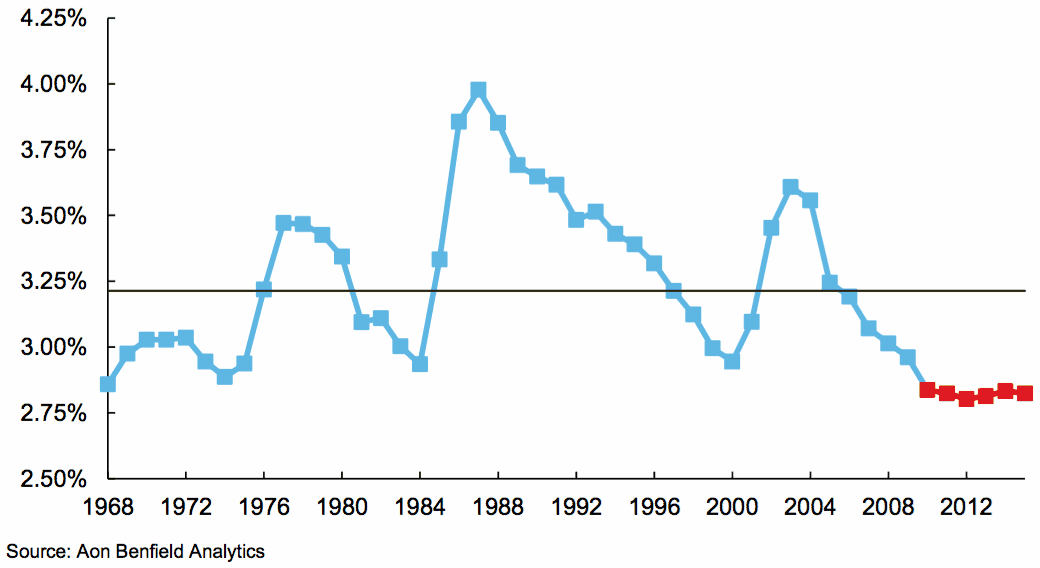Alternative capital and insurance-linked securities (ILS) may be a “more efficient risk engine” for the insurance and reinsurance market, providing evidence for structural change and the death of the underwriting cycle, according to Aon Benfield.
In order to call the current disruption in insurance and reinsurance a “new normal” or to predict that “this time it is different”, solid evidence is required before calls for the end of the underwriting cycle are given credence.
Alternative capital and ILS provides this evidence, reinsurance broker Aon Benfield suggests in its latest market outlook report (which we covered previously here), with the inflows of new, lower-cost capital helping to moderate (and perhaps kill) the reinsurance market cycle.
Aon Benfield provides in its report a view of U.S. property casualty premium as a percentage of GDP, which it says shows a proxy for the impact of the industry on the overall economy. The chart below shows that chart over 48 years, with a projection for 2015.

U.S. property casualty premium as a percentage of GDP
The report explains; “Over the last five decades the penetration of the industry has oscillated around its long-term average of 3.2 percent. For industry veterans the graph tells the well-known history of the malpractice/inflation/asset hard market of the 1970s, the casualty/liability/LMX spiral induced hard market of the 1980s and the more recent fall out from 9/11, and the soft market of the late 1990s. But today, the graph has a new feature: the unprecedented stability of the last six years.”
This “unprecedented stability” seen over the last few years can be attributed to the levels of reinsurance and risk capital, dampening the cycle and the fluctuations seen over previous years, with the inflows of alternative and ILS capital clearly a key factor in this structural change.
Since 2010 the ratio of premium to GDP has ranged by just four basis points, Aon Benfield notes, from a high of 2.84% in 2010 to a low of 2.8% percent in 2012. The broker estimates 2.82% for 2015, down one basis point on 2014, leading it to ask “Are underwriting cycles dead?”
Aon Benfield notes that in order to call the death of the underwriting cycle, the evidence must provide true structural reasons for the change, to which it notes; “Evidence we believe is provided today by alternative capital.”
The broker explains that alongside the development of catastrophe models, the most important development in insurance over the last two decades has been “radical improvements in the technologies available to deploy capital very quickly, as and where needed: the story of alternative capital.”
This has enabled new capital to flow rapidly into insurance and reinsurance after shock loss events, which would typically cause large fluctuations in pricing and rates-on-line. This was historically to take advantage of attractive rates and what Aon Benfield terms “hot spots” in the market, but today this has changed.
“Today we have capital moving in aggressively even where there are no hot spots, simply because it provides a more efficient risk bearing mechanism for insureds—in the form of side cars, permanent hedge fund sponsored insurers, and other similar mechanisms,” Aon Benfield explains.
This efficient and lower-cost capital may be permanent, the broker explains, and it is “having profound changes on how insurance companies structure their balance sheets and bear risk.”
Coming from investors with long-term horizons, such as pension funds, Aon Benfield urges insurers to incorporate alternative capital and ILS into their underwriting capital structures, whether directly through a self-sponsored vehicle of some description, or via reinsurance backed by this new capital.
“This new capital may be a more efficient risk engine in the market. Failure to leverage this new engine may result in an industry with less competitive rates and a gradual erosion of GDP share,” the report warns.
In the current climate it is essential that re/insurer management and boards “ensure their capital risk engine is running at maximum efficiency,” Aon Benfield explains, making it vital that alternative capital and ILS is seriously looked at and embraced.
It’s also important for insurers and reinsurers to realise that ILS and alternative capital is no longer limited to the catastrophe risk-driven tail and that it can be incorporated into capital structures across the risk spectrum.
Ultimately Aon Benfield urges clients to embrace alternative capital and ILS to discover how they can “lower your cost of underwriting capital and improve your competitive position in the market.”
If indeed alternative capital has driven a new normal and it is now time to call for the death of underwriting cycles, as Aon Benfield suggests, then further growth of ILS is assured. The only way traditional companies can adapt to a re/insurance market with no cycle, or a significantly flatter cycle, is to become more efficient and there cost-of-capital is key and bringing efficient capital within a companies underwriting structure is one of the best ways to achieve this.
Also read:
– Alternative reinsurance capital growth outstrips traditional: Aon Benfield.
 View all of our Artemis Live video interviews and subscribe to our podcast.
View all of our Artemis Live video interviews and subscribe to our podcast.
All of our Artemis Live insurance-linked securities (ILS), catastrophe bonds and reinsurance video content and video interviews can be accessed online.
Our Artemis Live podcast can be subscribed to using the typical podcast services providers, including Apple, Google, Spotify and more.































